Ready or not, new flying machines are headed our way. Correction, they are already here and a wave of similar entries could follow (see earlier reports). The earliest market-ready arrivals qualify under FAR Part 103.
 I believe this website needs to report these aircraft, so with pleasure, I announce the following to be perhaps the first multicopter pilot report from “one of us.” Scott Severen is a longtime LSA pilot, the importer of Jabiru aircraft, and the newly-elected President of LAMA, the Light Aircraft Manufacturers Association. Scott offers his impressions as one of the very first non-company pilots to fly one of these aircraft.
I believe this website needs to report these aircraft, so with pleasure, I announce the following to be perhaps the first multicopter pilot report from “one of us.” Scott Severen is a longtime LSA pilot, the importer of Jabiru aircraft, and the newly-elected President of LAMA, the Light Aircraft Manufacturers Association. Scott offers his impressions as one of the very first non-company pilots to fly one of these aircraft.
Some call them multicopters (me). Some prefer eVTOL. C’mon, have you said a mouthful like “eVTOL” to any non-pilot? …or even to most pilots? They look at you blankly, “Huh?” Marketers of these aircraft have yet to settle on a catchy word to identify them. “Drone” is still widely used but it’s not specific enough for man-carrying aircraft. So, I’m sticking with multicopter for any aircraft that does not pivot its wings or powerplants. If you prefer, insert your term of choice whenever I write multicopter.
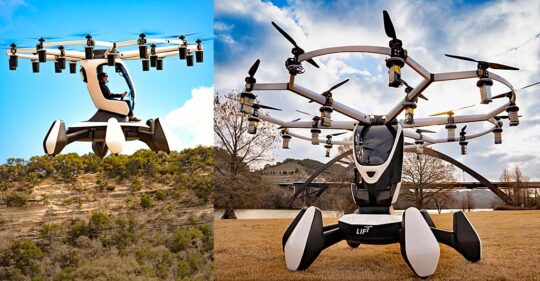
Scott has the titles I referenced above but he is also a very experienced hang glider, Part 103 ultralight, microlight, and LSA pilot with experience across the aviation spectrum for nearly his whole life (his father was U.S. Air Force). Scott knows more about light aircraft than most other individuals on the planet. I consider him an excellent choice for this pilot report on Lift Aircraft’s Hexa. Enjoy! —DJ
A New Way of Flying
…eVTOL…
YES, YOU CAN!
A new kind of ultralight is emerging. Unfamiliar flying machines combine familiar ideas with new technologies — sometimes created from scratch — to provide a fresh new opportunity for more people to safely achieve one of man’s oldest dreams.
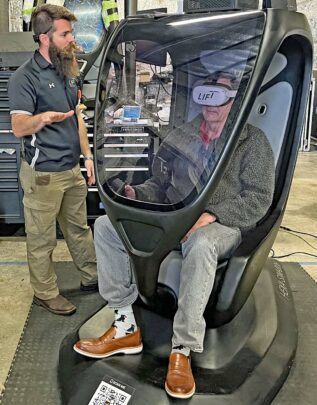
Jace “Digit” McCown, Director of Flight Operations and Chief Pilot for Lift Aircraft, gives simulator training to Scott Severen (in VR headset).
The Ultralight eVTOL, or multicopter, is a battery-electric vehicle with multiple motors and rotors (propellers). Being ultralight, they are single occupant and, yes, they are easy to fly with some training. No FAA pilot certificate is required. How do you prepare for this new sensation of flight?
Simulators are an excellent training tool and Lift Aircraft uses them to great benefit. With or without previous flight experience, just a few minutes of Hexa sim time builds your confidence creating excitement about flying Hexa.
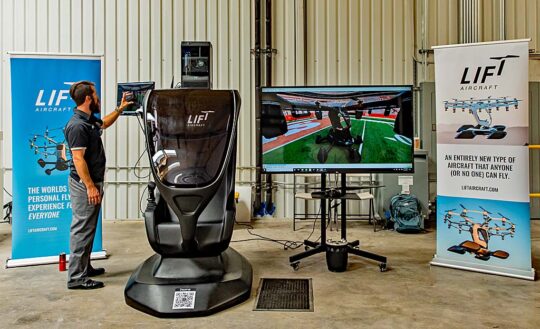
SIMULATOR TRAINING — Lift used about a half hour of simulator training: Take off, stabilize, land. Then take off, gain altitude, twist left and right. Then fly a giant square: fly forward about 100 feet, slide left, fly backward, then slide back to your starting point. Finally, fly forward and make a turn in one direction or the other. If you can do these things OK, then students get to “free fly” for a couple minutes. ••• A ground-based training covering regulations, airspace, and safety took another half hour.
While sims are great for preparation and familiarization, they do not re-create real life experience gained by flying. Just ask the sim pilots that tried to re-create Sullenberger’s flight when he chose landing on the Hudson River.
Describing Hexa
While simple in appearance, Hexa requires a preflight as any pilot would expect. Hexa is an all-carbon structure, using an overhead set of 18 independent motors, each with its own battery. These elements are easy to visually inspect.
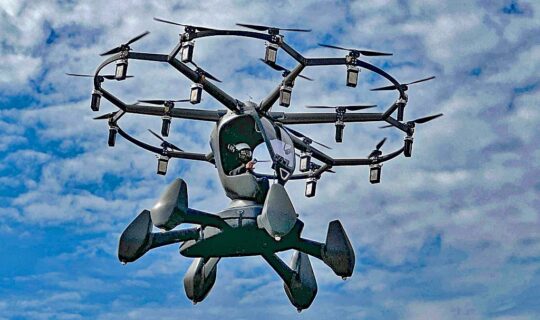
Redundancy Redefined — Hexa can lose up to 6 random or 2 adjacent powerplants and still maintain normal flight, engineers report. Hexa employs three redundant control systems. If one system has a glitch, number 2 takes over, and so on.
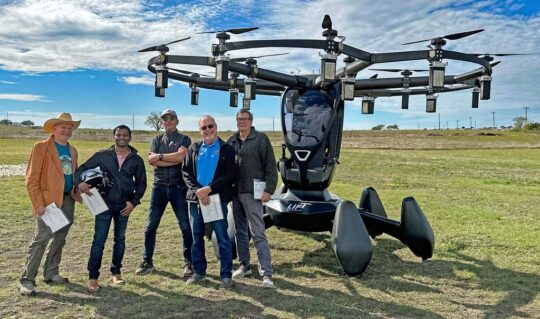
Stepping up into the cabin, you buckle the four-point pilot restraint. A windshield moves air around the pilot but the sides are open and lend a very “out there, open cockpit” feel.
Cockpit “Interface”
The nearby image depicts how the Flight Screen and Control Systems are presented on Hexa, and how you interact with Hexa. Such information systems are unique to each Part 103 ultralight eVTOL. (Scott has examined several Part 103 eVTOLs as part of LAMA’s program of providing a Technical Standards Committee to review aircraft wishing to approach FAA to qualify as Part 103 vehicles. Scott’s experience is rare. Few industry people have scrutinized several of these entries. —DJ)
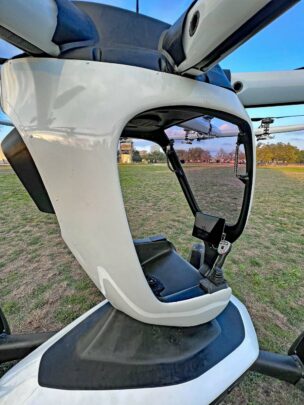
No rows of controls or banks of switches in this clean cockpit.
Hexa’s 12.1-inch touch-screen displays flight and powerplant information:
- wind direction/speed
- groundspeed
- compass
- flight direction
- home
- altitude expressed in AGL (Above Ground Level)
- how much flight time (battery) remains
- back-up button controls for Takeoff, Land, and Go Home
Lift’s joystick is the primary pilot interface with the aircraft. The screen provides information and backup buttons for the three main controls: takeoff, landing, and go home. The joystick describes four possible motions the pilot can initiate: longitudinal (banking); lateral (nose attitude); yaw (rotation about the vertical axis); and vertical (up/down).
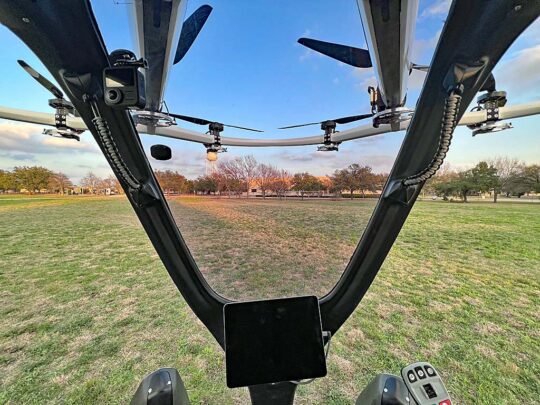
PILOT’S VIEW — Here’s the view that greets pilots entering Lift’s Hexa Part 103 multicopter.
Hexa presents three physical buttons on top of the stick for Take Off, Land, and Go Home. A switch you push up or down with your thumb directs Hexa to go up or down. On the front of the stick is a switch you move left or right with your index finger which activates yaw, or rotation about the vertical axis, like a pirouette except both feet stay on the floorboard.
Oh, and that’s all your feet have to do: rest on the floorboard.
The joystick moves fore and aft, left and right, or any combination of those movements. This prompts Hexa in the direction the stick is moved. The further you move the stick, the faster you move. Altitude remains the same. A key message for fixed wing pilots is that you are not trading altitude for airspeed when you move the stick, unlike what your three-axis training taught you.
Take Off and Landing
After a systems check and initialization, you are ready to “start your motors.” If you have multiengine training, this may sound like an unusual step, but Hexa makes it easy. You start all 18 motors at once resulting in a soft buzz, all in surround sound.
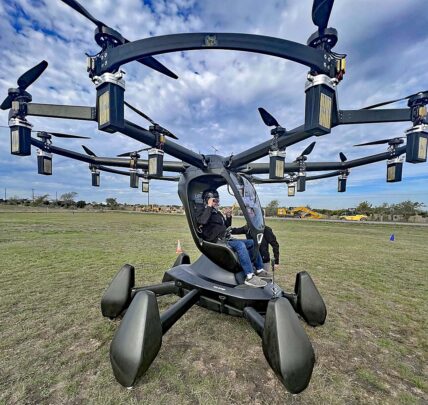
Scott’s brother Gary Severen prepares to fly Hexa.
Pressing the Take Off button on top of the joystick initializes the launch sequence and lifts you to about 10 feet in the air. At this point you set about your flight. You just toggle the up/down switch until you get to the desired altitude, then release. On my flight, I chose up to about 30 feet as the winds picked up to between 10-15 miles per hour.
I found it interesting that since Hexa uses GPS for its position, it tilted into the wind just enough to keep me centered above the take-off spot. It doesn’t matter what direction the wind is coming from, Hexa tilts into the wind enough to do its job… technology wonderfully applied.
Next, I practiced yawing left and right. A helicopter can do this maneuver, but it is simple in Hexa: you just move the switch on the front of the stick in the direction you want to twist. With no other inputs Hexa holds its position faithfully above the initiation spot, as though a plumb bob was hanging below. I found the flight experience very comfortable.
Flight Time — Typical battery range is about 20 minutes. This term depends on how much power you use for maneuvers: the more you climb, the more power is used; the more level flight at slower speeds, the less power you use. Some will say 20 minutes is far too little but for what Hexa is attempting today, that may be sufficient.
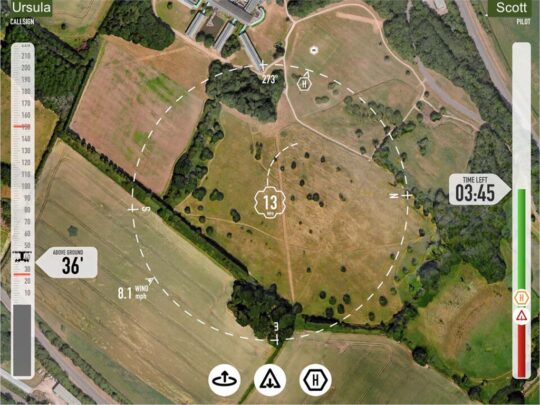
“Sliding” is another neat trick. It’s so easy in Hexa. Move the stick left and slide sideways to the left.
I have to say, backing up in the air is an intriguing sensation. Just pull the stick back, a little or a lot. On my flight, I was geo-fenced, so there was no worry about backing into anything, though Hexa also has sensors for collision avoidance. You can see behind you a bit just by rotating your head and body. I didn’t loosen the pilot restraint to allow torquing my body out of the cockpit to see directly behind.
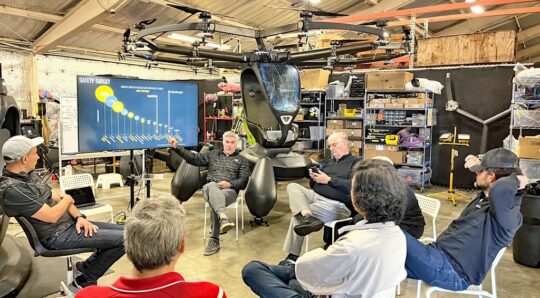
Lift Aircraft Founder Matt Chasen (pointing) speaks to prospective pilots of his Part 103 Hexa multicopter.
Once you’ve mastered the basic maneuvers, you can manipulate the controls to interact in many interesting ways. You can fly forward (or backward) while yawing/pirouetting. You can fly a “facing forward” square: forward stick, up button, aft stick, down button. You can finesse the controls to make a giant vertical circle, like on a Ferris Wheel, or you can scribe a lateral circle. You can fly forward and climb, then reverse the actions and go backwards “downhill.” Or, you twist around to see your descent. Imagine a 3-dimensional dance floor…
Hexa presents a moving map on the glass display, though all I referenced was how much battery remained. I found so much to enjoy outside of the cabin but not to worry, Hexa will take you “home” to your lift-off spot before you run out of battery. It’s pretty smart that way.
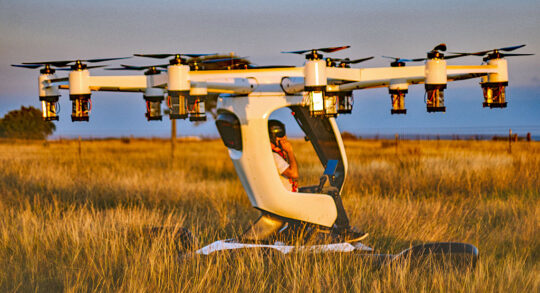
Hexa is a blast to fly and no flight experience is needed. A high confidence level comes quickly, supported by the inherent safety of all the redundant systems including a ballistic airframe parachute, one optimized for Hexa’s common low altitude of operation. This parachute system is autonomous; it fires if it senses a non-recoverable situation. A pilot does not really have time to assess the situation then pull a handle from 40 feet in the air.
You won’t want to miss an opportunity play in the skies with Hexa when you get the chance! The company plans tours to get more people airborne in a Lift Hexa
Thanks, Scott, for that fun look at Hexa. I don’t know about you but when I’m anywhere near one of these whirlybirds, I’m going up in it! —DJ
ARTICLE LINKS:
- Earlier article with lots of facts and info about Lift Hexa, from January 2022
- Lift Aircraft, contact info and all content on this website
- US Sport Planes, Scott Severen‘s Jabiru import business
- LAMA, the Light Aircraft Manufacturer’s Association, organization website
- Multicopter articles, published on this website
Watch Scott Severen and his brother Gary fly Hexa by Lift Aircraft in this short video.



As of 03-08-2024 I still haven’t seen HEXA do a water landing, fly 60 MPH plus or fly over 40 feet above the ground. So far all I ever see are videos of a slow moving hovering toy. Why doesn’t Lift Aircraft demonstrate what they claim the HEXA can do? I did invest in them because I love the concept, however I will not invest any more until I see what they claim HEXA can do. I believe what I see and not what I hear or read. If they desperately need investor money then they should demonstrate the HEXA capabilities. What are the hiding?
Very interesting🤔
I love this idea. I’ve dreamed of a hybrid like this. With a tiny, super efficient generator and reduced battery weight, it would fly longer and sell tomorrow.
Stay tuned. A hybrid version has recently popped on the radar.
That’s really cool…
Looking forward to seeing how this new found technology progresses in the future. Hope just like the computers of years past things will progress fast with more competition, more choices and reduced pricing will follow.
What I see is another terribly impractical toy. The article didn’t mention its price, but I’m guessing it’s above that of any ground-car EV. It’s tall, so it won’t fit into anyone’s residential garage. Parking it, or a bunch of them, anywhere but some wide-open field seems an unlikely prospect. But with a mere 20-minute range and a speed less than that of a ground car, one isn’t going very far. It’s an interesting technology demonstrator for simplified flight controls, but other platforms are exploring the same territory. Regrettably, it won’t meet my own transportation needs nor those of anyone I know. It fails the primary functional test for the fulfillment of the dream of personally directed movement safely from any point to any point via the shortest distance in the shortest time. I hate to discourage honest efforts toward it, but this one doesn’t seem to qualify. It’s much ado about nothing, to employ Shakespeare’s phrase.
It is only currently impractical, stressing currently because endurance or flying time is too low and the configuration is complicated compared to the Jetson 1 and the Pivatol Helix. The Jetson 1 appears affordable, particularly finding a used one; around 400 have been built so far; or are being built. So eVTOLS only appear impractical; is probably the break through product of this millenia for revolutionizing personal transportation. If you have the where with all to purchase a Jetson 1 and add batteries, maybe a 2nd seat and avionics; you will have a true commute eVTOL/automobile that will land anywhere space is available; a true revolution in transportation. For anyone with this where with all, no more traffic jams to deal with anywhere. Just stay above the traffic jams with the appropriate avionics in the craft: transponder and short distance radar primarily to show: wires, trees, other aircraft, and any obstruction. You can store your street legal eVTOL in your garage, carport, or on your property; rather than at an airport or heliport. Eliminating the need for an airport or heliport. It does not get any better than this for basic transportation within the endurance range of any particular eVTOL; looking for endurance of at least 1.5 hours; preferably 2.5 hours or more. With electric charging stations at most interstate highway rest areas; no limits exist on where one can go in an eVTOL. Just home work to know the rest areas have electric charging stations and a phone call to insure the charging stations are operational. If you fly small fixed wing aircraft; going somewhere new requires checking the runway condition, parking, and avgas availability via a phone call to the airport in question; for reference and safety. Sorry, you are not looking forward; which is essential in this instance. eVTOL – electric vertical take off and landing aircraft; automobile size in this instance.
Ok, now the two big questions…..
Cost of the Hexa and length of time to recharge the batteries. Thanks!
I doubt they can match the cost of the Jetson 1 unless someone is subsidizing them; which is probably a not. The Jetson 1 appears to be the least complicated of all the eVTOLS; have a width around 8 feet making it street legal. Without being street legal; one has to use a heliport or airport. Adding this intermediate location is last choice; really no choice. An eVTOL must be able to operate anywhere an auto operates plus above where any auto operates to get out of traffic jams that exist everywhere. This probably means a close in radar display of around a half mile for overhead wires, and any other obstructions above. But is doable.